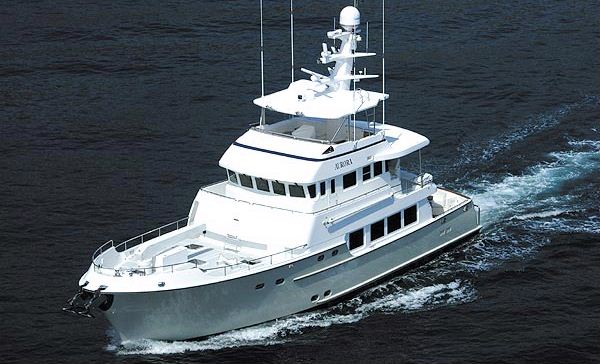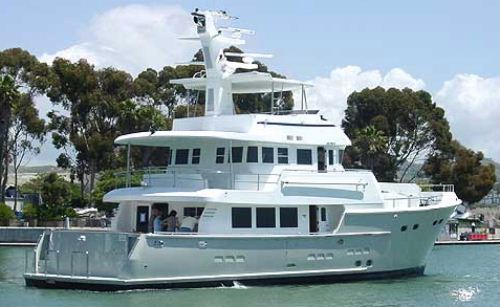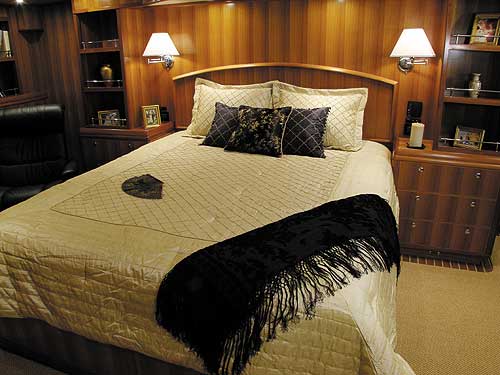 Nordhavn 76
Nordhavn 76
With popularity of the “northwest trawler”-style boat on the rise, PAE set out to create a new, big modern passagemaker that fused this salty look with the advanced systems of the latest Nordhavns. The result was the Nordhavn 76: developed for those yachtsmen who want an aft pilot house boat which carries its shore boats on the foredeck. Like our venerable Nordhavn 62, the pilothouse of the N76 is set aft, carries its crane forward and can launch its shore boats off either the port or starboard side. Based on the hull form and specifications of the N72, the simple goal of this new model was to create a small superyacht which was true to the rugged ocean going heritage of other Nordhavns while at the same time stunning in her elegance, fit and finish, systems and engineering.
The boat was taken from drawing board to factory seamlessly through the efforts of Naval Architect Jeff Leishman, along with the design and engineering team at PAE, and the Taiwanese builders at our partner factory, Ta Shing. The final product has exceeded everyone’s goals.
Nearly a year was spent in the tooling and mold-building phase of this project to create the hundreds of highly polished molds required to construct this complex boat in gleaming gel coat finished GRP (fiberglass) construction.
The Nordhavn 72 took PAE to the next level and the 76 has taken off from there. An interior decorator was commissioned to up the degree of style most megayachts are known for – including crown moldings, granite, leather, well-engineered lighting, and the finest appliances. Though a little more glitzy, there’s no denying that a Nordhavn exists at the heart of this boat. Numerous handrails, half-inch tempered glass windows, watertight doors and bulkheads and many other features essential for safe operation offshore.
Like the 72, the fact that this boat is so complete, a regular options list does not exist. Standard on the 76 is chilled water air conditioning, TRAC stabilizers, bow and stern thrusters, Marquipt davit, wing engine, dry exhaust, two inverters, 20 batteries, windlass and ground tackle, and a lot more. Simply add your electronics package, tenders on deck, personal affects you’re ready to go.

The highly developed standard AC and DC electrical systems on the N76 achieve a new level of sophistication for Nordhavn and allow for semi-automatic operation of this feature-packed vessel by a small crew or even one couple.
The standard propulsion configuration of the N76 is classic Nordhavn. The single main engine is the highly respected Detroit Diesel series 60 in the 535HP configuration and with its 25,000-hour life expectancy, should outlast most of us. Dry exhaust and keel cooling are standard as is the Lugger 668 wing engine.
The N76 is also available in a twin-engine configuration. Through clever design and forethought during the tooling phase of the project, keel molds for the twin engine layout were built and can be inserted into the main hull mold prior to lamination. This feature provides twin keels and protection for the shafts and propellers of the twin screw layout.
Another choice that the buyer of an N76 is given is whether or not to have a bulbous bow or conventional bow. The N76 hull mold has two different bow configurations (conventional and bulbous) which are interchangeable and set up prior to hull lamination. The bulbous bow provides benefits but also has an unpleasant side to it and thus has become somewhat controversial in recent years. We will discuss with you your intended use of your Nordhavn 76 and help you decide which bow configuration is right for you.
Unlike other semi-custom yachts out there, buying a Nordhavn 76 need not be stressful or risky. The N76 is fundamentally a fiberglass production boat built in molds on an established production schedule by a highly competent team, which has been together for 30 years. Scheduled completion dates are imperative to us and are met reliably or within a few days or weeks. Systems, engineering and performance are solid, well-developed and proven. You can inspect existing N76s to witness how special the fit and finish of this boat really is. Climb on board and get a feel for how comfortable it is to operate, and on a sea trial, experience the smoothness, low noise levels, sea kindliness and comfort.
Within the “production boat” safety net, you can still customize your Nordhavn with décor, equipment and features to achieve your desires. No two N76s will be alike, but all will share the same quality, seaworthiness, factory support and excellent resale value
 Accommodations
Accommodations
The Nordhavn 76 brings luxury, comfort and detail to a level unmatched in any other vessel her size. Complementing the elegant yet businesslike exterior, the Nordhavn 76’s interior features the gorgeous woodwork for which P.A.E.’s craftsmen are famous and is further enhanced by the work of yacht interior designer Scott Cole of Ardeo Design. Granite counter tops, stone flooring, rich carpet, leather and the finest available entertainment equipment, appliances, fittings and fixtures are all standard on the Nordhavn 76.
“For the flagship of our Nordhavn line, we rose the level of standard features to the highest possible point and included many items as standard that are options on other vessels,” said Dan Streech, president of P.A.E. The 14-page standard equipment list includes products from Bose, RCL, Sony, Sub Zero, Thermadore, PCM, Exalto, Bosh, Cantilupi, Carlisle & Finch, Glendenning, Charles, Grohe and more.
To the generous 21-foot beam add a relatively high profile with lots of hull below the waterline, mix in P.A.E.’s decades of experience building more than 500 oceangoing yachts and it becomes easier to understand how the Nordhavn 76 can provide such spacious accommodations.

Cruising Details
After building over 500 oceangoing yachts and voyaging hundreds of thousands of miles in them, the design team at P.A.E. has developed a design approach that creates vessels of impeccable cruising ability. The Nordhavn 76 has been designed to be an elegant, yet business-like, long-range passage maker, easily handled by two people that will continue to perform at its peak decades after its commissioning.
Carrying 4,100 gallons of fuel, the Nordhavn 76 has the range to cross any of the world’s oceans with ease. Showcasing our latest work in fuel systems, hydraulics, electrical, air conditioning, anchor systems, dry exhaust, fire suppression and more, the Nordhavn 76 will be totally reliable and self-sufficient, providing owners with comfort and safety in the world’s most remote locations.
The foundation of the Nordhavn 76’s success is its solid-fiberglass construction. In building the hull, the first three laminations below the waterline incorporate isopthalic gelcoat and vinylester resins to resist water penetration. All additional layers are a solid series of laminates for superior strength. Ten full-length, heavy-duty longitudinal stringers are glassed to the hull to provide strength and rigidity. Additional stringers are used in the engine beds, beneath the floor and under the deck. All cabin-side vertical surfaces are constructed with Klegecell #R75 in varying degrees of thickness and cabin top and deck horizontal surfaces are cored with Baltec 1-inch thick end-grain balsa. The topsides to 18 inches above the waterline are cored with 3/4–inch end-grain balsa. The deck-to-hull joint is fastened with 3/8-inch stainless-steel through-bolts on 8-inch centers using 3M’s 5200.
Likewise, all hull appendages are designed and built to withstand the unexpected abuses of distance cruising. The 4 ½-inch diameter stainless steel Aquamet 22 prop shaft (fitted with a Spurs line cutter) drives a Hungshen 50- by 31-inch, four-blade, left-hand rotation prop. From the 30-inch stainless-steel destroyer-type wheels in the wheelhouse or on the flybridge, you will find the steering smooth and steady as the Kobelt hydraulic steering system powers the 3 ½-inch Aquamet 22 rudder shaft and ½-inch stainless steel-plate, rib-stiffened rudders. The rudder assembly is protected and strengthened by a two-piece stainless steel, rudder carrier shoe.
The standard power configuration of the Nordhavn 76 is as a single screw vessel with dry exhaust, but it is also available with twin engines. In the twin-screw configuration, special inserts are installed in the mold that allows twin skegs to be part of the original integral lay-up of the hull.
The hull mold for the Nordhavn 76 has been designed in a way that enables us to offer the boat with or without a bulbous bow. The bow section of the hull mold is removable and interchangeable with bulbous and conventional bow molds so that the buyer can choose either bow and still receive a one-piece seamless hull. The result is a solid hull capable of withstanding anything that you and Mother Nature put it through.
The deck layout is fully optimized for shorthanded cruising. Owners may choose from either a standard layout with the wheelhouse in the middle of the boat, or the more traditional aft pilothouse version.
Starting at the bow in the standard layout, you will find massive stainless steel, double anchor rollers custom made to handle two 300-lb. Aritex plow anchors plus additional, lighter ground tackle and mooring lines. Dual Maxwell VWC 4500 hydraulic windlasses lead two 400-foot lengths of ½-inch HT chain from huge lockers that are accessible from Freeman watertight storm hatches on deck. These cavernous below-deck lockers include longitudinal shelves and will stow dock lines, fenders, extra ground tackle and more. Anchoring, even on a pitching foredeck, is a safe, secure task thanks to the heavy-duty safety rails and sure footing of the molded, diamond pattern non-skid.
Lined with stainless steel handrails atop the bulwarks, the foredeck includes Lewmar Ocean Series opening hatches for the forward cabins that provide excellent ventilation, especially at anchor. Outside air is also supplied through louvered intake and from dorade vents via ducts to the master, forward guest and lower staterooms. The Nordhavn 76 includes a complete Cruisair tempered water air-conditioning system with control panels throughout the cabin. The wheelhouse also includes opening windows for additional ventilation.
Moving aft on the standard layout Nordhavn 76 you will ascend to the bulwarked Portuguese Bridge—an excellent vantage point to stand watch or handle docking maneuvers. On either side of the bridge are control stations for DDC (engine) control, bow and stern thruster controls, and start, stop, and horn functions. The Portuguese Bridge includes P&S storage lockers vented with stainless louvers.
Above the wheelhouse is a roomy flying bridge with full engine control and room for guests to relax and enjoy the view. The flybridge includes a FRP hardtop with sink, Sub Zero drinks refrigerator, Stidds Slimline helm chairs and a cushioned settee with high-gloss teak table. A sturdy hardtop offers protection from the sun and light showers.
The pilothouse is designed for maximum efficiency. The varnished teak floors and cabinetry accented by dark gray Formica counters give the spacious 270-square-foot wheelhouse a warm and clean look. The pilothouse includes a teak dinette table and settee with chart drawers underneath. Two Stidds Low Back Slimline helm seats offer an excellent vantage point for steering and navigating. The pilothouse has ample storage for books, charts and navigational tools. A pilothouse head with teak floors and cabinets and granite countertops prevents the need to leave the deck. Adjoining the pilothouse is a carpeted crew quarters with teak trimmed lockers and a double sized bed. The cabin includes more bookshelves and a TV locker.
A distinctive feature of the Nordhavn 76 is its gleaming FRP exhaust stack and radar mast with flag halyards on port and starboard.
Aft of and below the flying bridge is a spacious deck above the main salon designed to house a large tender. With more than 345 square feet of space, the deck accommodates tenders up to 17 feet. Included as a standard feature is the 80-gallon gasoline storage tank with electric pump so that you will always have fuel for the tender. Launching your tender is easy with the Marquip 2500-lb. hydraulic 240-volt davit and boom (extendable to 21 feet) mounted on port aft side. The davit has been sized and positioned to launch dinghies from the port side and stern.
From the Portuguese bridge, you will reach the main deck through a protected stairwell and can enter the main salon through Weather Tight Dutch doors or continue to the aft cockpit. Along this path, the crew enjoys protection from the seas with extra high bulwarks and the added security of stainless steel handrails that are through-bolted along the entire length of the cabin. Blue water quickly finds itself overboard thanks to the large scuppers along the decks and in the cockpit. All cleats, hawseholes and chocks are highly polished stainless steel, custom made and designed to properly secure the boat in any docking situation. Boarding doors on either side open in two pieces for easy access on or off the boat, and are tightly secured when on the water. All exterior fittings are heavy duty and designed to protect the vessel from abuse including nine stainless steel hawse fittings, twin bollards aft of forward windlasses, and thick stainless rub rail upper and lower rub rail caps.
The lower aft deck offers a roomy place to enjoy the outdoors. With more than 120 square feet of unobstructed space, you can grill, entertain or just sit back and enjoy the view. The aft deck includes an exterior cabinet for storage with a sink and faucet as well as a control alcove for DDC engine control with American Bow Thruster bow and stern thruster jog legers, rudder angle indicator and steering jog as well as start/stop, air horn and forward windlass control. To make docking easy, the aft deck sports twin Maxwell VC2200 24v port and starboard capstan winches.
The result of this uncompromising attention to detail is a large and solid cruising vessel with an ergonomically designed layout to facilitate cruising for an adventurous couple
Hull Design
The Nordhavn 76, like it’s smaller sister, the N72, carries through the progression of P.A.E.’s modified full displacement (MFD™) hull design which achieves superior sea-keeping qualities, longer range and greater speed than other full-displacement vessels of similar sizes. Evident in the other models in the line, the MFD™ hull design features full stern sections to minimize pitching motion and to maximize weight-carrying capacity. The unique shape of the stern section also helps maximize the top cruising speed capable by reducing drag caused by “squatting”, common to full displacement hulls running at high speed-to-length ratios. The MFD™ hull design includes a slight tunnel area for the propeller, allowing a large diameter prop to be used without increasing draft. This large diameter prop increases efficiency and reduces cavitation, creating a quieter running boat.
Employing innovative tooling design, P.A.E. also offers optional engine and bow configurations. While the standard configuration is a single-screw vessel, the Nordhavn 76 molds have been designed to include inserts for twin skegs as part of the original hull lay up. Bulbous and conventional bow molds are removable and interchangeable allowing the buyer to choose either bow and still receive a one-piece seamless hull.
P.A.E. did not rely solely on theory as it developed its MFD™ hull for the Nordhavn 76. Instead it invested heavily in a complete tank-testing program at B.C. Research in Vancouver, Canada. Among the breakthroughs achieved during this extensive R&D program were the addition of MAINTENANCE STRAKES™ to the bottom of the MFD™ hull, which create gentle bulges in the hull form directly below the engine location. Not only do these revolutionary devices provide six feet four inches of headroom in the engine room, they also allow the engine to sit lower for enhanced stability, minimum shaft angle and optimum thrust. The tank testing also revealed a surprising 2% increase in overall hull efficiency due to the positive effect the MAINTENANCE STRAKES™ have on the vessels’ performance at higher cruising speeds. An interesting first with the Nordhavn 76 is the incorporation of root cord fairing pads into the hull design. The tear drop shaped flat surfaces port and starboard on the hull conform to the sweep of the stabilizer fins and insure a close precision fit between the top of the fin and the hull surface throughout the full range of the fin movement. This tight gap prevents “spillage” of water over the top of the fin and thus increases the efficiency and performance of the fin foil dynamics. Similar gains are found at the bottom of the stabilizer fin by use of the ABT TRAC “winglets” which also reduce spillage and increase efficiency.
The performance chart indicates a practical, economical speed range of between 9.5 and 10.5 knots for the Nordhavn 76. At these speeds, she has a range of between 3,800 and 2,400 nautical miles, burning between 9.7 and 17.4 gallons-per-hour. It is quite revealing that most long-range or rough weather cruising is done at speeds below l0 knots, even by boats capable of far higher speeds. Not only are many boats uncomfortable at higher speeds, but also their owners soon discover that all the noise and rapidly moving scenery are not conducive to an enjoyable voyage. Additionally, if an owner has long-range cruising plans, the economics of running high horsepower, planing boats often preclude the desire to go faster than displacement speeds. Compare burning 8 gallons per hour traveling at 8.5 knots in a NORDHAVN 76 with 30 gallons per hour in a planing boat during a four-week cruise while running 4 to 5 hours per day, and one quickly appreciates the efficiency of a full displacement hull. Even if the faster boat’s number of hours per day are reduced to compensate for higher speeds, there is a huge difference in fuel consumption and operating costs.
Most importantly, the crew of a Nordhavn MFD design will arrive rested and relaxed, ready to enjoy their new surroundings. After completing his first long voyage, one Nordhavn owner, who sold his fast, planing boat said it best: “This was the fastest voyage I ever made on the slowest boat I’ve ever owned.”
